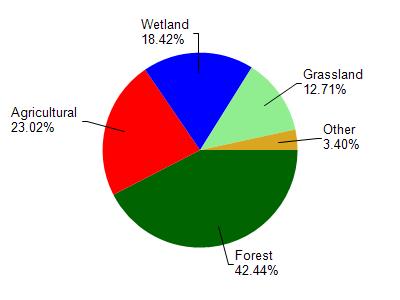Waupaca
No
No
No
Fish and Aquatic Life
Overview
Ogdensburg Pond, in the South Branch Little Wolf River Watershed, is a 64.64 acre lake that falls in Waupaca County. This lake is managed for fishing and swimming and is currently not considered impaired.
Date 2011
Author Aquatic Biologist
Historical Description
Source: 1971, Surface Water Resources of Waupaca County Ogdensburg Millpond, T23N, R12E, Sections 21, 22 Surface Acres = 61.9, S.D.F. = 3.71, Maximum Depth = 9 feet.
Ogdensburg Millpond is a very irregularly shaped impoundment of Engebretson Creek and contains clear, hard water. Water levels are maintained by a four-foot dam owned by Beitzel Mill. There are 3 spillways each creating a small outlet stream that eventually merge and form a navigable channel to the North Fork South Branch Little Wolf River. The inlet stream is navigable. Sand, gravel, boulder, rubble, and detritus are the predominant littoral bottom materials. Perch, largemouth bass, bluegill, black crappie, pumpkinseed, and bullhead are present. Northern pike and white sucker are less numerous. Natural water level fluctuations and occasional severe winterkills make good management difficult. Bullheads may become overabundant if there is a succession of severe winterkills. Abundant aquatic vegetation interferes with other types of recreational management of this pond. The upper one-half of the pond is surrounded by a marshy wetland supporting a significant population of muskrats. Mallards and bluewing teal nest near the lake and migrant puddle ducks stop over for resting and feeding. Hunting is allowed outside of the corporate limits. Access with parking is provided by one county road and two town streets. Two dwellings are present.
Date 1971
Author Surface Water Inventory Of Wisconsin
Condition
Wisconsin has over 84,000 miles of streams, 15,000 lakes and milllions of acres of wetlands. Assessing the condition of this vast amount of water is challenging. The state's water monitoring program uses a media-based, cross-program approach to analyze water condition. An updated monitoring strategy (2015-2020) is now available. Compliance with Clean Water Act fishable, swimmable standards are located in the Executive Summary of Water Condition in 2018. See also the 'monitoring and projects' tab.
Reports
Recommendations
Drawdown of Water
Ogdensburg Millpond Drawdown
Management Goals
Wisconsin's Water Quality Standards provide qualitative and quantitative goals for waters that are protective of Fishable, Swimmable conditions [Learn more]. Waters that do not meet water quality standards are considered impaired and restoration actions are planned and carried out until the water is once again fishable and swimmable
Management goals can include creation or implementation of a Total Maximum Daily Load analysis, a Nine Key Element Plan, or other restoration work, education and outreach and more. If specific recommendations exist for this water, they will be displayed below online.
Monitoring
Monitoring the condition of a river, stream, or lake includes gathering physical, chemical, biological, and habitat data. Comprehensive studies often gather all these parameters in great detail, while lighter assessment events will involve sampling physical, chemical and biological data such as macroinvertebrates. Aquatic macroinvertebrates and fish communities integrate watershed or catchment condition, providing great insight into overall ecosystem health. Chemical and habitat parameters tell researchers more about human induced problems including contaminated runoff, point source dischargers, or habitat issues that foster or limit the potential of aquatic communities to thrive in a given area. Wisconsin's Water Monitoring Strategy was recenty updated.
Grants and Management Projects
Monitoring Projects
| WBIC | Official Waterbody Name | Station ID | Station Name | Earliest Fieldwork Date | Latest Fieldwork Date | View Station | View Data |
|---|
| 273800 | Ogdensburg Pond | 10019198 | Ogdensburg Millpond -- Access | | | Map | Data |
| 273800 | Ogdensburg Pond | 694004 | Ogdensburg Pond - Ogdensburg Pond | 8/1/1979 | 8/1/1979 | Map | Data |
| 273800 | Ogdensburg Pond | 10007340 | Ogdensburg Pond | 7/27/1999 | 8/21/2011 | Map | Data |
|

Watershed Characteristics
Ogdensburg Pond is located in the South Branch Little Wolf River watershed which is 160.29 mi². Land use in the watershed is primarily forest (42.40%), agricultural (23%) and a mix of wetland (18.40%) and other uses (16.10%). This watershed has 166.00 stream miles, 2,070.64 lake acres and 19,091.22 wetland acres.
Nonpoint Source Characteristics
This watershed is ranked Low for runoff impacts on streams, High for runoff impacts on lakes and High for runoff impacts on groundwater and therefore has an overall rank of High. This value can be used in ranking the watershed or individual waterbodies for grant funding under state and county programs.However, all waters are affected by diffuse pollutant sources regardless of initial water quality. Applications for specific runoff projects under state or county grant programs may be pursued. For more information, go to surface water program grants.